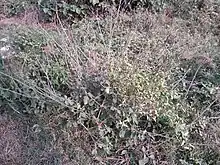Achyranthes aspera
Achyranthes aspera (common names: chaff-flower,[1] prickly chaff flower,[2] devil's horsewhip,[3] Sanskrit: अपामार्ग apāmārga) is a species of plant in the family Amaranthaceae. It is distributed throughout the tropical world.[4] It can be found in many places growing as an introduced species and a common weed.[5] It is an invasive species in some areas, including many Pacific Islands environments.[6]
| Achyranthes aspera | |
|---|---|
 | |
| Scientific classification | |
| Kingdom: | Plantae |
| Clade: | Tracheophytes |
| Clade: | Angiosperms |
| Clade: | Eudicots |
| Order: | Caryophyllales |
| Family: | Amaranthaceae |
| Genus: | Achyranthes |
| Species: | A. aspera |
| Binomial name | |
| Achyranthes aspera | |
Uses
The juice of this plant is a potent ingredient for a mixture of wall plaster, according to the Samarāṅgaṇa Sūtradhāra, which is a Sanskrit treatise dealing with Śilpaśāstra (Hindu science of art and construction).[7]
It is one of the 21 leaves used in the Ganesh Patra Pooja done regularly on Ganesh Chaturthi day.
Traditional medicine
A. aspera has been used in folk medicine in countries including Australia,[8] India,[9] and Kenya.[10]

The 1889 book The Useful Native Plants of Australia records that this plant was found "in all the tropical and sub-tropical regions of the old world. The herb is administered in India in cases of dropsy. The seeds are given in hydrophobia, and in cases of snake-bites, as well as in ophthalmia and cutaneous diseases. The flowering spikes, rubbed with a little sugar, are made into pills, and given internally to people bitten by mad dogs. The leaves, taken fresh and reduced to a pulp, are considered a good remedy when applied externally to the bites of scorpions. The ashes of the plant yield a considerable quantity of potash, which is used in washing clothes. The flowering spike has the reputation in India (Oude) of being a safeguard against scorpions, which it is believed to paralyse. (Drury.)"[8]
In Uttar Pradesh, the plant is used as a herbal medicine, especially in obstetrics and gynecology, with the intention of treating abortion, induction of labor, and postpartum bleeding.[9]
The Maasai people of Kenya use the plant medicinally to ease the symptoms of malaria.[10]
Chemical constituents
Achyranthes aspera contains triterpenoid saponins which possess oleanolic acid as the aglycone. Ecdysterone, an insect moulting hormone, and long chain alcohols are also found in Achyranthes aspera.[11]
References
- "BSBI List 2007". Botanical Society of Britain and Ireland. Archived from the original (xls) on 2015-01-25. Retrieved 2014-10-17.
- Flowers of India
- USDA Plants Profile
- Flora of North America
- "Achyranthes aspera". Germplasm Resources Information Network (GRIN). Agricultural Research Service (ARS), United States Department of Agriculture (USDA). Retrieved 2018-01-02.
- Pacific Islands Ecosystems at Risk
- Nardi, Isabella (2007). The Theory of Citrasutras in Indian Painting. Routledge. p. 121. ISBN 978-1134165230.
- J. H. Maiden (1889). The useful native plants of Australia : Including Tasmania. Turner and Henderson, Sydney.
- Khan, A. V. and A. A. Khan. Ethnomedicinal uses of Achyranthes aspera L. (Amaranthaceae) in management of gynaecological disorders in western Uttar Pradesh (India). Archived November 24, 2010, at the Wayback Machine Ethnoleaflets.
- Bussmann, R. W.; Gilbreath, G. G.; Solio, J; Lutura, M; Lutuluo, R; Kunguru, K; Wood, N; Mathenge, S. G. (2006). "Plant use of the Maasai of Sekenani Valley, Maasai Mara, Kenya". Journal of Ethnobiology and Ethnomedicine. 2: 22. doi:10.1186/1746-4269-2-22. PMC 1475560. PMID 16674830.
- Indian Herbal Pharmacopia Vol. II, Page-5.